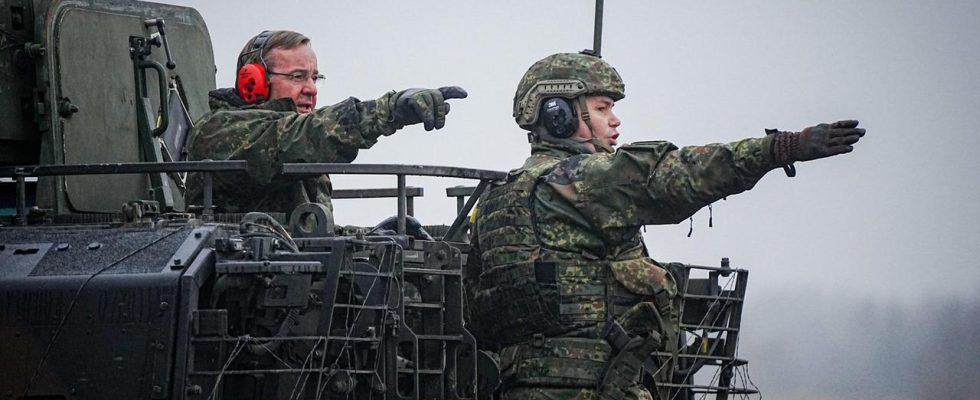background
Today the Bundestag is once again dealing with the state of the Bundeswehr. Despite changing times and special funds, numerous deficiencies and construction sites remain. Where exactly? An overview.
Despite 100 billion in special funds and the Chancellor’s “turning point”, the Bundeswehr continues to have personnel, material and financial problems. This emerges from the report by the Defense Commissioner of the German Bundestag, Eva Högl. Among other things, it calls for “substantial improvements in personnel, materials and infrastructure”.
Today the Bundestag is dealing with the state of the Bundeswehr. Where are the problems? An overview.
The force lacks personnel
“The troops continue to age and shrink,” writes Defense Commissioner Eva Högl in her annual inventory for the Bundestag. The average age of soldiers increased from 33.5 in 2022 to 33.8 last year. The number of applicants for the Bundeswehr has fallen slightly. For years, thousands of positions above the enlisted ranks have not been filled.
The goal of increasing the number of soldiers from the current 182,000 to at least 203,000 soldiers by 2031 is difficult to achieve – Högl states soberly and not for the first time in her military report. Presumably also because just 13 percent of those wearing uniforms in the Bundeswehr are women.
The Armed Forces Commissioner sees a solution to staffing needs in a “social year”. Young women and men would have to do this in areas such as social affairs, the environment, culture or the Bundeswehr. Nobody wants to go back to the old conscription, which was suspended in 2011. Simply because there isn’t enough accommodation, equipment and trainers.
In view of the glaring shortage of personnel, Defense Minister Pistorius is currently having various conscription models from other countries analyzed. The “Swedish conscription model” is considered the favorite. It includes compulsory military service, although not entire cohorts are drafted into the army. Even if Pistorius commits himself by the middle of the year, it will probably take some time before the Bundeswehr really grows again. Because a “new” conscription could require a constitutional change with a two-thirds majority in the Bundestag and Bundesrat and that would probably take time.
The Defense Minister hoped for quicker success through a task force to recruit personnel. He also recently appointed a new head of human resources at the Ministry of Defense.
The Material problem
The soldiers’ personal equipment has now improved. But there is still a lack of cartridges for rifles, entire tanks or spare parts for repairs. With regard to the material, the Bundeswehr is “not yet fully operational”. Despite the special fund worth 100 billion euros.
One reason for this is the transfer of weapons systems and ammunition to Ukraine: self-propelled howitzers 2000, multiple rocket launchers “Mars II”, “Leopard” 2A6 main battle tanks, artillery ammunition and most recently a Patriot anti-aircraft missile system, for example, went to Ukraine. Since the beginning of the Russian war of aggression, according to government information, Germany has handed over material from the Bundeswehr’s stocks alone with an estimated procurement value of over five billion euros. Although additional orders have been placed, Ukraine support has initially torn holes in the equipment, some of which will not be closed for years.
At the same time, the demands on the Bundeswehr are increasing: Germany has promised NATO a fully equipped army division that can be deployed at short notice by 2025. The planned Lithuania Brigade is to become part of the approximately 30,000 soldiers. By 2027, a complete German combat unit with 4,800 soldiers will be stationed abroad for operational purposes for the first time.
However, their equipment will leave gaps in other associations. Army Inspector Alfons Mais has in the ARD explains that in the next three to five years “we will have to sweat out the necessary personnel and material from the army’s structures in order to send them to Lithuania.” Procurement will take years.
According to plans by the Ministry of Defense, armaments investments amounting to six to nine billion euros are necessary to build a combat-ready German brigade on NATO’s eastern flank in Lithuania.
Financial questions remain unresolved
Defense Minister Pistorius urgently needs money not only for the establishment of the Lithuania Brigade. He is also demanding significantly more money from Finance Minister Lindner for the regular defense budget for 2025. There are demands of up to 6.5 billion euros for new investments. And so that Germany once again meets NATO’s so-called two percent target. This year, according to government figures, Germany reached its goal of spending two percent of its economic output on the military for the first time in three decades.
In the medium term, more money is also needed because the Bundeswehr’s special fund of 100 billion euros is now planned for new weapon systems and ammunition and will last until 2027 at the most.
After that, things look bleak: At the beginning of the year, “Spiegel” reported on an impending budget gap in 2028 amounting to around 56 billion euros, referring to an internal financial needs analysis by the Ministry of Defense, which was also reported by the Ministry of Defense ARD capital studio is present. Even if things don’t turn out that bad, there will definitely be billions missing for the medium-term financing of the Bundeswehr. Where they come from is still completely unclear.
Uli Hauck, ARD Berlin, tagesschau, April 25, 2024 11:14 a.m

